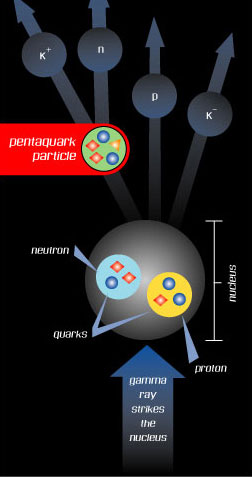Wonderful World of Pentaquarks: Information for Scientists

Although research is on-going, evidence is mounting in favor of the existence of a new subatomic particle known as the pentaquark. Up until now, all of the experimentally well-established particles (several hundred of them) fit into only two categories: baryons, made up of 3 quarks, and mesons, made up of "two" quarks (specifically, a quark and an anti-quark). The pentaquark, made up of "five" quarks (specifically, 4 quarks and 1 anti-quark), that was found is the first example of a new classification of particle known as an exotic baryon.
(Note: when counting the number of quarks, the anti-quark cancels with one of the quarks. For example, mesons have so-called baryon number zero. Hence the pentaquark is technically part of the baryon family, with 4-1=3 quarks, but an exotic one if the anti-quark has a different "flavor" than the other quarks--more on this below.)
Let's review "Particle Physics 101". The classic example of a baryon is the proton, with two "up" quarks and one "down" quarks. In short-hand notation, the proton has configuration (uud). Similarly, the neutron has configuration (udd). The classic example of a meson is the positive pi-meson, or just "pi+", with one up quark and one anti-down quark, configuration (u d-bar). In addition to the u- and d-quarks, the other known quarks are the strange (s), charm (c), top (t) and bottom (b) quarks, giving a total of 6 flavors of quarks. The many different combinations of quarks allowed by the standard theory of the strong interaction, Quantum Chromodynamics (QCD), gives rise to the known subatomic particles. The new pentaquark has configuration (uudd s-bar), where the s-bar has a different flavor, and hence cannot annihilate with, the other u- and d-quarks.
The pentaquark is allowed by the rules of QCD, but up until now, there was no experimental evidence of pentaquarks even though there were many searches in the 1970's and beyond. This led some people to question why the mathematical solutions to QCD, which are very difficult to compute, might not include pentaquarks. Now that a pentaquark has been found, we hope to learn more about the non-perturbative solutions to QCD, but this will take a lot of future theoretical efforts.
The motivation to look for the pentaquark came from a very specific prediction from a paper by Diakonov, Petrov and Polyakov (DPP). While this theoretical model is only an approximation to QCD, and hence subject to criticism about its assumptions, they predicted that the pentaquark would be found with a mass of 1530 MeV and a narrow width (less than 15 MeV). The work of DPP is, of course, built upon previous theoretical advances by other people, but the DPP model was sufficiently specific in its mass prediction that it motivated experimenters to search in their data for this particle.
The experimental evidence from 3 separate laboratories shows, in all cases, a sharp peak at about 1540 MeV with a width that is limited by the experimental resolution. The signal is small, and hence this pentaquark is difficult to detect, but clear with a large statistical significance (ranging from 4.5 to 5.5 standard deviations in the experiments).
While it is tempting to claim that the measured signal is validation of the theoretical model of DPP, more measurements are needed to determine the properties of the pentaquark. For example, the spin of this pentaquark (predicted to have spin 1/2) have not yet been established, but will be in future experiments. Another explanation of the experimental results could be a meson-baryon "molecule" state, which would likely have different properties than the particle predicted by DPP (the details are still being worked out). The experiments do not depend on the theoretical model of DPP being correct, but the experiments are consistent with the predictions of this model at present.
In summary, there is recent evidence from 3 separate experiments that a pentaquark exists with a mass of about 1540 MeV and a narrow width. There have been searches for pentaquarks in the past, but none were found. A theoretical prediction at a specific mass was made, which motivated experimenters to search for this particle. However, the experimental results are not dependent on whether this particular theoretical model is correct or not. The pentaquark establishes a new classification of subatomic particles known as "five"-quark objects (also known as exotic baryons).
Information Courtesy of Kenneth Hicks

